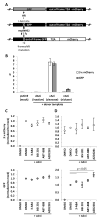PARP-mediated repair, homologous recombination, and back-up non-homologous end joining-like repair of single-strand nicks
- PMID: 23684799
- PMCID: PMC3683368
- DOI: 10.1016/j.dnarep.2013.04.004
PARP-mediated repair, homologous recombination, and back-up non-homologous end joining-like repair of single-strand nicks
Abstract
Double-strand breaks (DSBs) in chromosomal DNA can induce both homologous recombination (HR) and non-homologous end-joining (NHEJ). Recently we showed that single-strand nicks induce HR with a significant reduction in toxicity and mutagenic effects associated with NHEJ. To further investigate the differences and similarities of DSB- and nick-induced repair, we used an integrated reporter system in human cells to measure HR and NHEJ produced by the homing endonuclease I-AniI and a designed 'nickase' variant that nicks the same target site, focusing on the PARP and HR repair pathways. PARP inhibitors, which block single-strand break repair, increased the rate of nick-induced HR up to 1.7-fold but did not affect DSB-induced HR or mutNHEJ. Additionally, expression of the PALB2 WD40 domain in trans acted as a dominant-negative inhibitor of both DSB- and nick-induced HR, sensitized cells to PARP inhibition, and revealed an alternative mutagenic repair pathway for nicks. Thus, while both DSB- and nick-induced HR use a common pathway, their substrates are differentially processed by cellular factors. These results also suggest that the synthetic lethality of PARP and BRCA may be due to repair of nicks through an error prone, NHEJ-like mechanism that is active when both PARP and HR pathways are blocked.
Copyright © 2013 Elsevier B.V. All rights reserved.
Conflict of interest statement
The authors declare that there are no conflicts of interest.
Figures




References
-
- Urnov F, Miller J, Lee Y, Beausejour C, Rock J, Augustus S, Jamieson A, Porteus M, Gregory P, Holmes M. Highly efficient endogenous human gene correction using designed zinc-finger nucleases. Nature. 2005;435:646–651. - PubMed
Publication types
MeSH terms
Substances
Grants and funding
LinkOut - more resources
Full Text Sources
Other Literature Sources
Research Materials
Miscellaneous

